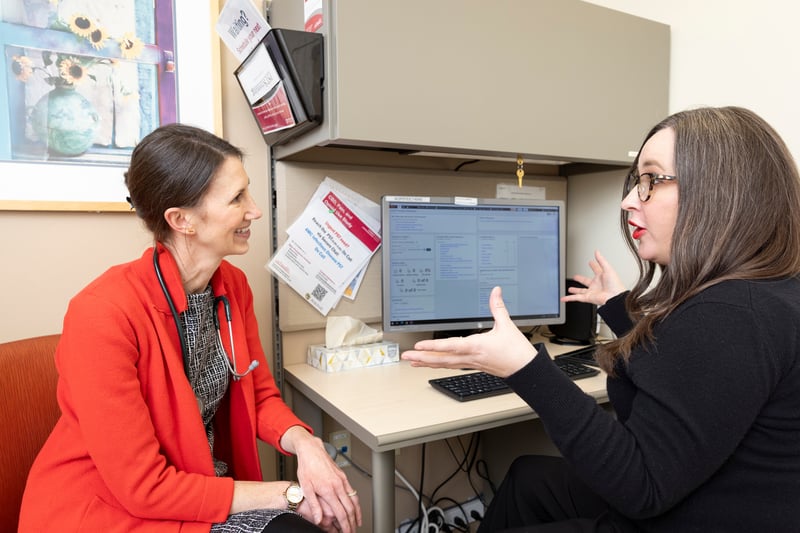A pair of University of Colorado Department of Medicine faculty members, seeking to enhance patient safety, led an effort to improve the accuracy of hospital discharge orders for patients who need intravenous antibiotics.
The initiative was focused on patients receiving outpatient parenteral antimicrobial therapy (OPAT), referring to intravenous antimicrobials (such as antibiotics, antifungals, or antivirals) administered outside the hospital. “Parenteral” means not administered orally.
The effort was led by Lorna Allen, FNP-C, an assistant professor in the department’s Division of Infectious Diseases, and Larissa Pisney, MD, an associate professor in the division. Both practice at UCHealth University of Colorado Hospital (UCH), which was the focus of their OPAT initiative. Pisney is the medical director for OPAT at UCH, and is also the medical director for infection prevention and control.
Shorter hospital stays
OPAT was introduced in the United States in 1974 as an alternative to extended hospitalization and is now used to treat about 250,000 patients a year nationwide, according to the Infectious Diseases Society of America (IDSA).
UCH began its OPAT program in 1997. Currently the system cares for 80 to 100 UCH patients a week, Allen says. OPAT patients at UCH often are being treated for bone and joint infections, bloodstream and heart infections such as endocarditis, and abscesses in various parts of the body, Pisney says.
OPAT “can dramatically shorten a hospital stay, which can prevent other health care-associated conditions from developing and get patients back to work or school sooner,” Pisney says, “And there can be significant health care cost savings as well as opening a hospital bed for the next patient.”
Room to improve
Nevertheless, Allen and Pisney saw a need to improve the discharge process for OPAT patients at UCH, which was often hampered by incorrect or missing treatment orders, a cumbersome workflow, and a lack of a standardized discharge process across hospital units, heightening concerns about patient safety risks.
The workflow for discharging patients on IV antimicrobials is inherently complex and challenging, they say. OPAT patients are discharged from the hospital into different settings for continued therapy. While most go home and receive antibiotics in the home or at an infusion center, about a third of patients go to various post-acute care sites such as skilled-nursing facilities and long-term acute care centers, making continuity of care a challenge and accuracy of medication orders vital.
Allen, Pisney, and their colleagues collected nearly two years of data that showed that about half of OPAT patients in the baseline study group left UCH with either inaccurate or missing orders for IV treatments on their discharge medication list. They also learned that treatment orders were omitted about half of the time on OPAT patients’ after-visit summary, the information sheets that discharged patients and post-acute care facilities get to guide their future care.
“Discrepancies and omissions on the discharge medication list have led to near miss and patient harm events during transitions of care including missed doses, wrong doses, and inappropriate cessation of IV antimicrobials,” Allen and Pisney described in a poster presented at IDWeek, a joint annual meeting of the IDSA, the Society for Healthcare Epidemiology of America, the HIV Medicine Association, the Pediatric Infectious Diseases Society and the Society of Infectious Diseases Pharmacists.
The sluggish workflow involved in discharging OPAT patients at UCH left case managers and clinicians feeling dissatisfied with the process, pre-intervention surveys showed.
 Lorna Allen, FNP-C, and Larissa Pisney, MD of the CU Department of Medicine's Division of Infectious Diseases. Photo by Justin LeVett for the CU Department of Medicine.
Lorna Allen, FNP-C, and Larissa Pisney, MD of the CU Department of Medicine's Division of Infectious Diseases. Photo by Justin LeVett for the CU Department of Medicine.
Holes in the Swiss cheese
During the baseline period, “there was a lot of routing of notes, which created a lot of opportunities for error as well as duplicative work for teams,” Pisney says. “We wanted to streamline work and, as much as we could, get rid of the holes in the Swiss cheese – the places where errors could occur.”
The one-year intervention led by Allen and Pisney began in September 2022. Says Allen: “The primary aims of the project were to standardize the discharge process, because it was being done differently on different units and by different providers, and then, to increase the frequency of accurate IV antimicrobial information on the discharge medication list and the frequency of including the OPAT orders on the after-visit summary.”
She adds: “We leveraged our electronic health record to improve and automate the process as much as possible,” so IV treatment orders would automatically flow onto a patient’s after-visit summary.” This involved hours of collaboration and revisions with Epic analysts -- the information-technology professionals who specialize in the Epic electronic health records software platform -- as well as Brian Montague, DO, director of quality and informatics for the Division of Infectious Diseases. Through the automation they created, four steps were eliminated from the pre-existing OPAT workflow.
The results: By August 2023, OPAT treatment orders were appearing on the discharge medication list 95% of the time and on the after-visit summary 99% of the time, much higher than the previous inclusion rates of 52% and 54% respectively. And a follow-up survey showed sharply increased satisfaction with the OPAT discharge process by primary teams.
Safety a priority
The OPAT discharge changes are now being adopted by other UCHealth hospitals in Northern Colorado. Future efforts will focus on educating new faculty and fellows in the revised system. Also, hospital readmission rates for OPAT patients will be analyzed to see if the changes result in improved patient outcomes.
A number of studies elsewhere have examined OPAT processes, including during the transition-in-care period, with an eye toward improving care.
Pisney and Allen see their project as a sign that health care safety is a priority at both the CU Anschutz Medical Campus and UCHealth. Allen sites a number of quality improvement resources on campus, such as the Department of Medicine’s Leaders in Informatics, Quality and Systems (LInQS) Fellowship Program and the IHQSE Clinical Effectiveness and Patient Safety (CEPS) Grant Program, that were helpful in the success of the project.
As a result of the LInQS role, Allen was able to receive coaching in quality improvement and statistical support from Heather Hallman, MSHS, MHA, CSSGB, the quality and patient safety program manager for the Department of Medicine.
“The work that Lorna and our nurses do every week to make sure that those 80 to 100 OPAT patients transition safely out of the hospital and continue to get their care safely at home is wildly important,” Pisney says. “And I think we’re lucky to work at an institution that really values the work that we’re doing.”
Photo at top: Lorna Allen, FNP-C, and Larissa Pisney, MD. of the CU Department of Medicine's Division of Infectious Diseases, at the infectious disease clinic at UCHealth University of Colorado Hospital. Photo by Justin LeVett for the CU Department of Medicine.





